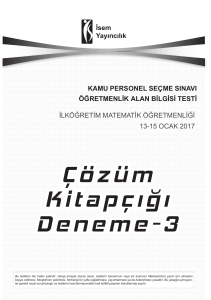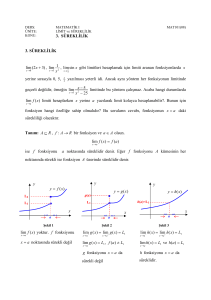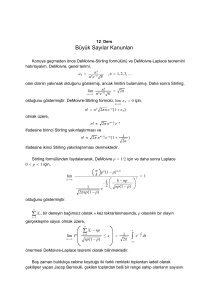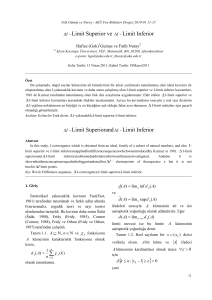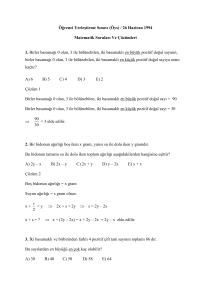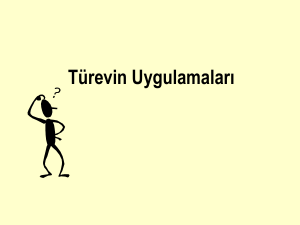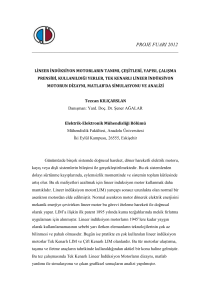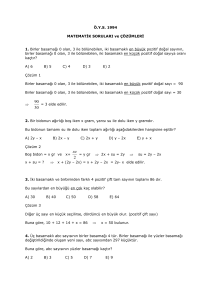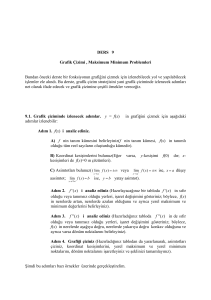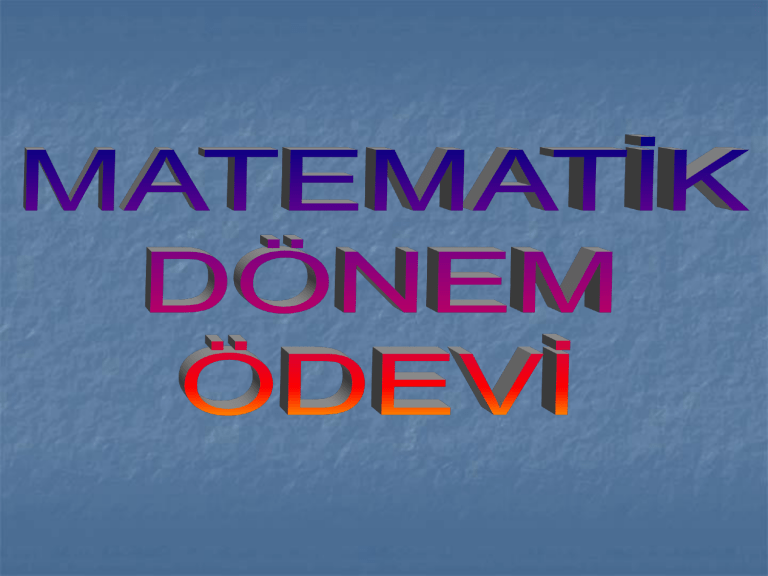
Tanım: Bir x0 A = [a,b] alalım. f : A R ye veya f : A -{x0} R ye bir Fonksiyon
olsun Terimleri A - {x0} Cümlesine ait ve x0’a yakınsayan her ( xn) dizisi için (f(xn))
fonksiyon değerleri dizisi daima sonlu bir L R sayısına yakınsıyorsa bu L sayısına f
f ( x) L şeklinde gösterilir.
fonksiyonunun x0 noktasındaki limiti denir ve lim
xx0
Tanımdan da görüldüğü gibi limit noktasının Fonksiyonunun tanım
cümlesine ait olma zorunluluğu yoktur yani x0 noktasında fonksiyon
tanımsız olsa bile bu noktada limit mevcut ola bilir.
y
1
2
x
Yandaki şekilde x=2 için
fonksiyon tanımsız
olmasına rağmen aynı
noktada fonksiyonun
limiti var ve 1’dir.
Örnek:
lim x3
x 2 2 x 15
?
x 3
Çözüm: x = 3 için f(x) tanımlı değildir. Yani x = 3 için kesrin pay ve
paydası sıfır olur ve sıfıt ile bölme tanımlanamaz, bu tanımsızlığı
ortadan kaldırdıktan sonra limite geçilir. x 3, x-3 0 olduğundan
pay ve paydayı x-3 ile bölelim.
x 2 2 x 15
( x 3)( x 5)
lim x3
lim x3
lim x3 ( x 5) 3 5 8 bulunur.
x 3
x 3
Sonuç:
Bir f(x) fonksiyonunun herhangi bir noktada
limitinin olması için o nokta da tanımlı olmak zorunda
değildir.
y
f (x )
1.X değişkeni bir c noktasına azalan değerlerle
(yani sağdan) yaklaştığı zaman bir limiti mevcutsa
bu limite fonksiyonun x = c noktasındaki sağdan
limiti denir ve lim xc f ( x) şeklinde gösterilir.
2. X değişkeninin c noktasına artan değerlerle (yanı
soldan) yaklaştığı zaman bir limiti mevcutsa bu
limite fonksiyonun x = c noktasındaki soldan limiti
denir ve lim xc f ( x) şeklinde gösterilir.
Bir f(x) fonksiyonunun limtinin olabilmesi için sağdan
ve soldan limitlerinin birbirine eşit olması gerekir.
.
L
.
x
c x
y
L
f (x )
x
x c
Sağdan ve soldan limitler her zaman sürekli olmayan
aşağıdaki dört çeşit özel tanımlı fonksiyonlarda uygulanır.
1. Parçalı sürekli fonksiyonlar
2. Mutlak değer fonksiyonlar
3. İşaret fonksiyonlar
4. Tam değer fonksiyomlar
bu fonksiyonların dışındaki sürekli fonksiyonlardan sağdan
ve soldan limitler birbirine eşit olduğundan doğrudan limit
alınır.
ÖRNEK 1:
f :RR
f ( x)
x 2 2 , x 3ise
3 x 4 , x 3ise
3- 3 3+
Yukardaki fonksiyonun tanımından da
görüldüğü gibi 3’ün sağında ve solunda
fonksiyon değişik değerler almıştır. Bu kritik
noktada limiti bulalım:
ÇÖZÜM:
lim x3 f ( x) lim x3 ( x 2) 3 2 11
2
2
lim x3 f ( x) lim x3 (3x 4) 3.3 4 5
lim x3 f ( x) lim x3 f ( x)
lim x3 f ( x)' in
olduğundan
limiti mevcut değildir.
ÖRNEK2:
f :RR
2 x 1, x 3
f ( x)
0, x 3
Fonksiyonunun x = 3 ve x = 4 noktalarında limitleri nedir?
ÇÖZÜM:
lim x3 f ( x) lim x3 f ( x) lim x3 (2 x 1) 2.3 1 5
lim x4 f ( x) lim x4 f ( x) lim x4 (2 x 1) 2.4 1 7
NOT: x’in 3 den farklı bütün değerleri için f(x) = 2x-1 olduğuna
ve limitlerinin bulunduğuna dikkat ediniz.
ÖRNEK1:
f : R 1 R
f ( x)
1 x
1 x
x
Fonksiyonunun x = 1 noktasında sağdan ve soldan
limitini bulunuz.
ÇÖZÜM:
X
1-x
-
1
+
+
-
1-x
-(1 - x)
lim x1 f ( x) lim x1 (1 x) 1 1 0
lim x1 f ( x) lim x1 (1 x) 1 1 2
ÖRNEK2:
f : R R, f ( x ) x 4
2
Fonksiyonun x = 2 noktasında sağdan ve
soldan limiti bulunuz. Bu noktadaki f(x)’in
limiti var mıdır?
ÇÖZÜM:
X
-
x2 - 4
+
-2
2
+
-
+
-x2+4
x2-4
lim x2 f ( x) lim x2 ( x 2 4) 22 4 0
lim x2 f ( x) lim x2 ( x 2 4) 22 4 0
lim x2 f ( x) lim x2 f ( x) lim x2 f ( x) 0.
x = 2 noktasında f(x)’in limiti vardır ve sıfırdır.
ÖRNEK1:
f : R R, f ( x) Sgn( x 3) Fonksiyonunun x = 3 noktasında
limitini araştıralım.
ÇÖZÜM:
X
x-3
-
3
+
-
+
-1
1
lim x3 f ( x) lim x3 sgn( x 3) lim x3 (1) 1
lim x3 f ( x) lim x3 sgn( x 3) lim x3 (1) 1
NOT: işaret fonksiyonların grafiklerinden de biliyoruz ki
fonksiyonlar işaret değiştirdiği kritik noktalarda soçrama
yaptığı için sağdan ve soldan limitleri farklıdır.
Dolayısıyle bu noktada limitleri yoktur.
ÖRNEK2:
lim x0 (sgn x
Limitini hesaplayınız
x
x
)
ÇÖZÜM:
x
lim x0 (sgn x ) 1 (1) 1 1 0
x
x
‘dır.
lim x0 (sgn x ) 0
x
Tam değer fonksiynu x R için x’den küçük olan en büyük tam
sayıya tamdeğer x denir ve x sembolüyle gösterilir.
Tamdeğer fonksiyonunda limit bulunurken x x x 1 oldığundan
sağdan yaklaşırken aynı değer alınır.
Soldan yaklaşırken aynı değerin bir eksiği alınır.
NOT: Limit alınıtken önce fonksiyon limit noktasında tanımlanır.
Sonra limite geçirilir. Çünkü tamdeğer fonksiyonu sabit fonksiyondur.
ÖRNEK1:
lim x2 3 3 x ?
lim x2 3 3 1,99.. lim x2 3 1,1..
lim x2 3 1 lim x2 2 2
ÖRNEK2:
f ( x) x 4 sgn( 2 x) x 2 x lim x2 f ( x) ?
2
ÇÖZÜM:
Önce fonksiyonu 2’nin sağ tarafındaki değerini bulalım.
X
-2
2
x2 - 4
+
-
+
2-x
+
+
-
lim f ( x) lim x 2 ( x 4 1 0 x)
2
lim x 2 ( x 5 x) 2 5 2 1
2
2
LİMİT TEOREMLERİ: f : A R, g : A R Tanımlı iki fonksiyon ve
lim xa f ( x) P, lim xa g ( x) q olsun.
1. a)Sabit bir sayının limiti o sayıya eşittir.lim xa c c
dir.
b)Sabit terim limitin dışına alınabilir.
i) t R lim xa (txn ) t lim xa x n ta n
ii) lim xa x n a n , lim xa ( x n ) a n
iii) lim xa f n ( x) (lim xa f ( x)) n p n
2. Toplamın limiti, limitlerin toplamına eşittir.
lim xa ( f g ) ( x ) lim xa f ( x) g ( x) lim xa f ( x) lim xa g ( x) p q
ÖRNEKLER:
lim x3 (2 x 5) 2 lim x3 x lim x3 5 2.3 5 1
lim x2 7 x 7 lim x2 x 7.2 14
lim x3 ( x 2 3x 1) lim x3 x 2 3 lim x3 x lim x3 1 32 3.3 1 1
x 1 lim x2 ( x 1) 2 1 3
lim x2
3
x 1 lim x2 ( x 1) 2 1 1
1.
lim xa sin x sin a; lim xa cos x cos a
lim xa tan x tan a; (cos a 0)
lim xa cot anx cot ana; (sin a 0)
2.
lim x 0
sin x
x
lim x 0
1
x
sin x
Sonuç:
sin Px p
sin px p
lim x0
; lim x0
qx
q
sin qx q
3. lim x0 tan x lim x0 x 1
x
tan x
Sonuç:
lim x0
tan p p
tan px p
; lim x0
qx
q
sin qx q
ÖRNEKLER:
lim
x 0
sin 3 x
3 lim
x
lim x0
2
2
sin x
sin x
sin x
lim x0
lim x0
1
2
x
x
x
2
lim x0
x 0
sin 3 x
3.1 3
3x
3 sin 2 x
sin 2 x
3
sin 2 x 3
lim x0
.
lim x0
lim x0
2.3 6
x. cos 2 x
x
cos 2 x
x cos 2 x
x 4 0
( x 2)( x 2)
lim x2
x2 0
( x 2)
2
1) lim
x 2
lim x2 ( x 2) 2 2 4
2
(
x
1
)
0
2
(
x
1
)(
x
1
)
2) lim x1
lim x1
0
x 1
( x 1)
lim x1 ( x 1) 2( 1 1).2.2 4
x 27 0
x 3
lim
x 3
2
2
2
x 9
0
x 3
3
3)
lim x3
lim x3
3
3
( x 3)( x 3x 9)
3 3.3 9
( x 3)( x 3)
33
2
27
9 3 2
6
2
2
2
Bu tür belirsizlikleri dizilerdeki gibi sadeleştirme işlemiyle ortadan
kaldırabileceğimiz gibi aşağıda göstereceğimiz pratik yolları da kullanabiliriz
lim x
a1 x p a2 x p 1 ....
b1 x q b2 x q 1 ....
şeklindeki bir limitte
i) Eğer p=q ise yani iki polinomun dereceleri eşitse limitin a1/b1 dir. Başka bir
deyişle limit en büyük dereceli terimlerin önündeki katsayıların oranıdır.
2 x 3x 2
3
ÖRNEK: lim x
2x2 5
2
ii) p<q ise yani paydanın derecesi payın derecesinden büyük ise limit sıfır dır.
ÖRNEK: lim x
3x 1
3x 1
0
,
lim
0
x
3
2
x 2x
x x
iii) p>q ise yani payın derecesi paydanın derecesinden büyükse limit veya
dur. ÖRNEK: lim x
x 3 3x
()31 () 2
x 3
ÖRNEK:
lim x
2 x 3 6 x 2 5x 2
lim x
3x 4
lim
x
5 2
2x 3 x 6 2
x x
3x 4
3
5
2
x 2 6 2
x
x
x
4
x 3
x
20 600 2 6
30
3
(a b)( a b) a 2 b 2
Bu tür belirsizliklerin giderilmesi için a b
eşitliğinden
ab
ab
yararlanacağız.
ÖRNEK:
lim x 2 x 2 x 2 x 3
lim x
2
2
2x 2x
2
2x 3
2
2x 2x
2
2x 2x 2x 3
2
2
2x 3
2
lim
2 x 2 2 x ( 2 x 2 3)
x
2
x 2
x
2
lim
x
x
lim
x
x
3
x 2 2
x
2
2x 3
2
3
2
x 2 2
x
x
3
x 2
x
2
3
2
2 2
x
x
20
20 20
2
2
2
2
2 2 2 2
lim x p( x)
İfadesinin limitini araştırırken önce p(x)’in derecesi
belirlenir.
i) p(x)’in derecesi çift ise
lim x p( x)
ii) p(x)’in derecesi tek ise
lim x p( x) lim x p( x)
lim x (an x n x n1 .... a1 a0 ) lim x an x n dir yani sadece en büyük
üslü terinim limitini
almak yeterlidir.
ÖRNEK:
lim x (3x 2 x x 4) lim x 3x
5
3
2
5
2 1 4
lim x x 3 2 3 5 .3
x x x
5
Tanımı: f(x) fonksiyonu x = a noktasında
aşağıdaki 3 şartı sağlıyorsa o noktada
süreklidir.
i) f(x) fonksiyonu x = a noktasında tanımlı
olması
ii) lim xa f ( x) L limiti olmalı
iii) lim xa f ( x) f (a) L olmalıdır.
f ve g fonksiyonları x = a noktsında sürekli iki fonksiyon olduğuna göre:
R
1)
olmak üzere .f fonksiyonu da x = a noktasında süreklidir.
2) f+g, f-g, f.g fonksiyonlar da x = a noktasında süreklidir.
3) g ( a ) 0 olmak üzere: f/g, 1/g, -g fonksiyonları da x = a noktasında
süreklidir.
4) fog, f , n f , f n fonksiyonlarda x = a noktasında süreklidir.
ÖRNEK:
f :R R
fonksiyonu
x 1, x 0
f ( x ) a , x 0
x 3 1, x 0
Şeklinde tanımlanan f(x)
fonksiyonu x = 0
noktasında sürekli olması
için a ne olmalıdır.
ÇÖZÜM:
i)
ii)
f ( x), x 0
noktasında tanımlıdır.
lim x0 f ( x) lim x0 ( x 1) 1
3
lim x0 f ( x) lim x0 ( x 1) 1
f (0) a lim x0 f ( x) 1
eşitliğinde a = 1 dir.
SORULAR:
3
lim x 1 5 ?
x
3
lim x 1 5 ?
x
3
3
lim x1 5 5
53 8
x
(1)
x 7 x 10
?
lim x2
x2
2
x 7 x 10
?
lim x2
x2
2
lim x2
x 2 7 x 10 2.2 7.2 10
0
x2
22
0
Belirsizlik olduğundan çarpanlara ayırarak belirsizlikten kurtaralım.
lim x2
( x 2)( x 5)
lim x2 ( x 5) 2 5 3
( x 2)
x2 1
x 1 , x 1
f ( x ) 1, x 1
İse lim x1 ifadesinin değeri nedir?
x 1, x1
x2 1
x 1 , x 1
f ( x ) 1, x 1
İse lim x1 ifadesinin değeri nedir?
x 1, x1
-
1
x2 1
f ( x)
x 1
1
+
x 1
lim x1 f ( x) lim x1 ( x 1) 1 1 2
lim x1 f ( x) lim x1
( x 1)( x 1)
11 2
( x 1)
X = 1 noktasında sağdan ve soldan limitleri eşit olduğundan
lim x1 f ( x) 2
lim
x
3 4x
?
2x 7
lim
x
3 4x
lim x
lim x
2x 7
II .Yol : n
3 4x
?
2x 7
3 3
x 4
4 4
x
2
7 2 7
2
x 2
x
İken pay ve paydanın dereceleri eşitse pratik olarak
limitin değeri ;eşit dereceli terimlerin katsayılarının
oranıdır. Yani -4/2 =-2’dir
lim
x
0
2 x
2 x
x
3 x
?
lim
x
0
2 x
2 x
x
3 x
?
2x x
2
x
x
lim
lim x0
x
0
2
x
3
x
2 x 3x
3x
lim x0
lim x0 (3) 3
x
lim
x 1
sin x 1
?
sin( x 2)
lim
x 1
sin x 1
?
sin( x 2)
sin x 1
lim x1
sin( x 1)
x 1 iken x 1 1 Sin ( 1) Sin1' dir .
x 1 iken 1 Sin ( x 1) 0
Sin ( x 1) 1Bunagöre
lim
x 1
Sin x 1
Sin1
Sin1
Sin ( x 1)
1
4 x 2 sgn( x 2)
2
lim x2
3x ?
x2
x x
4 x 2 sgn( x 2)
2
lim x2
3x ?
x2
x x
4 x 2 1
2
lim x2
3x
x 2 x 1
(2 x)(2 x) 1
2
lim x2
3x
x 1
( x 2)
1
1
23
2
lim x2 x 2
3x (2 2) 3.4
2 1
3
x 1
1
lim x1
?
x 1
1
lim x1
?
x 1
y
f ( x)
1
x 1 fonksiyonunun grafiği
yanda görülmektedir. Buna göre
lim x1 f ( x) , lim x1 f ( x)
olduğundan, yani f(x) fonksiyonun
x = 1 noktasında sağdan ve soldan
limitleri farklıdır,dolayısıyla x = 1
noktasında f(x)’in limiti yoktur.
1
-1
x
3 x,2 x 1
f : 2,3 R, f ( x) 0, x 1
lim x1 f ( x) lim x1 f ( x) ?
2 x 1,1 x 3
3 x,2 x 1
f : 2,3 R, f ( x) 0, x 1
lim x1 f ( x) lim x1 f ( x) ?
2 x 1,1 x 3
1
-2
3
3
3-x
2x-1
lim x1 f ( x) lim x1 (2 x 1) 2.1 1 1
lim x1 f ( x) lim x1 (3 x) 3 1 2
lim x1 f ( x) lim x1 f ( x) 1 2 1
lim
x2
sin
x2
?
sin( x 2)
lim
lim x 2
x2
sin
x2
?
sin( x 2)
Sin x 2
0
0
sin( x 2)
lim x 2
( x 2)
sin x 2
.
x2
sin( x 2)
lim x 2
sin x 2
. lim x 2
x2
x2
sin( x 2
sin x 2
x2
. lim
lim x 2
1. 1 1' dir
x 2
sin( x 2)
x2
sin x
x
(lim x0
lim x0
1)
x
sin x
2 x 1, x 0
f : R R, f ( x) 0, x 0
lim x0 f ( x) ?
x 2 1, x 0
2 x 1, x 0
f : R R, f ( x) 0, x 0
lim x0 f ( x) ?
x 2 1, x 0
0
f ( x) 2 x 1
0
+
x2 1
lim x0 f ( x) lim x0 ( x 2 1) 02 1 1
lim x0 f ( x) lim x0 (2 x 1) 2.0 1 1
lim x0 f ( x) 1
lim x3 2 x x ?
3
lim x3 2 x x ?
3
lim x3 ( 2 x x ) lim x3 ( 2 x 3)
3
3
( 2.3 3)3 33 27' dir .
( x 3 iken x 3
Olduğuna dikkat ediniz.
x 2x 3
?
3
x x4
2
lim x
x 2x 3
?
3
x x4
2
lim x
2 3
2
3
x 1 2 1
x x
lim x
1 4
1 4
2
x x 2
x x
1 0 0 1
0' dir .
00
2
x
3 , x 1
f : R R, f ( x) 0, x 1 lim x1 f ( x) lim x1 f ( x) ?
1
, x 1
3
x
3 , x 1
f : R R, f ( x) 0, x 1 lim x1 f ( x) lim x1 f ( x) ?
1
, x 1
3
1 1
lim x1 f ( x) lim x1
3 3
x 1
lim x1 f ( x) lim x1
3 3
1 1 2
lim x1 f ( x) lim x1
3 3 3
f ( x) x x...limh 0
2
f ( x h) f ( x)
h
İfadesinin eşiti
nedir?
f ( x) x x...limh 0
2
f ( x h) f ( x)
h
İfadesinin eşiti
nedir?
f ( x) x 2 x,
f ( x h) ( x h)2 ( x h)
lim h0
f ( x h) f ( x )
( x h) 2 ( x h) ( x 2 x )
lim h0
h
h
lim h0
h2 2 xh h
x 2 2 xh h2 x h x 2 x
lim h0 (h 2 x 1)
lim h0
h
h
0 2x 1 2x 1' dir.

